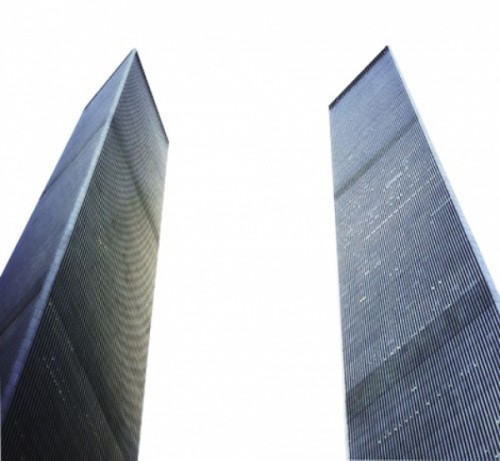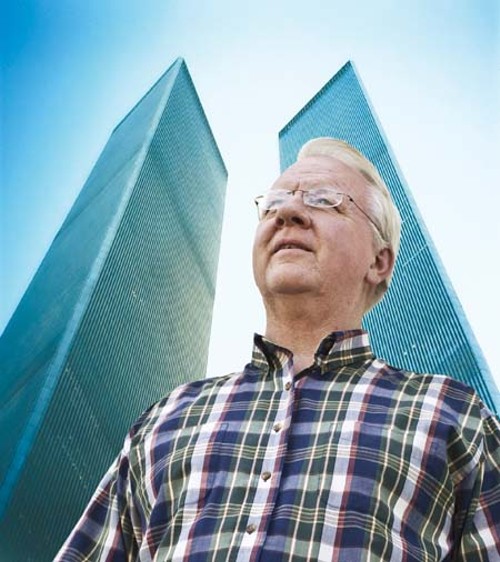We All Fall Down
After 9/11, BYU prof. Steven Jones’ teaching career imploded just like the twin towers, but he still insists planes were not to blame.
By Eric S. Peterson @ericspetersonThe equation for free fall is pretty basic. Drop
anything—from a dime to a rock—from a tall
building, for example, and once that object hits
an acceleration of 9.8 meters per second squared,
it’s free falling. This equation applies to everything,
even to buildings.
In the fall of 2005, Brigham Young University professor Steven Jones presented this simple principle in a BYU campus auditorium packed with hundreds of people to illustrate how several of the World Trade Center towers fell too quickly on Sept. 11, 2001, to have only been hit by planes. To reach free-fall speed, Jones explained, the building’s floor supports would have needed to be blown apart. In other words, the carnage of 9/11 would have required another catalyst of destruction beyond hijacked planes—an explosive to cause the buildings to implode.
The discussion ran two hours and only ended because students began arriving for a class to be held in the room. Before concluding, Jones asked if anyone was not convinced more investigation was needed. Only one professor raised his hand. “And he tracked me down the next day on campus and told me I changed his mind,” Jones says.
Jones’ speech began his rise as an outspoken skeptic of
the official 9/11 report. But, it was also the beginning of the
end for his career as a college professor.
Jones and his colleagues theorized that a military-grade explosive called nano-thermite sliced through the building supports and brought down the buildings. Recently, they bolstered their theory with analysis of a mysterious powder collected from around New York City, a powder they asserted in the April 2009 Open Chemical Physics Journal was nano-thermite.
If the theory sounds like bad science fiction, it is because a
similar explosive substance, “nanomite,” was used by Cobra (the
bad guys) in this summer’s over-the-top action movie, G.I. Joe: Rise
of Cobra. In the movie, Cobra uses nanomite to disintegrate buildings
and national monuments in a cloud of green dust.
Nano-thermite, however, is no green powder from comic
book fiction—it’s actually a red-chip substance that Jones and
his researchers have matched specifically to an explosive residue
using electron microscopy.
But before Jones recent red-chip research came to fruition, he
continued to speak frankly about other pieces of the puzzle: the
reported sounds of explosions on 9/11, molten steel at the site, steel
beams shooting out horizontally like missiles from the buildings,
and the sloppy federal explanations about what happened at World
Trade Center 7, the third building that collapsed and the only one that
did so without being hit by any planes.
Jones now casually rattles off the official testimony that claimed air defenses were called off and describes suspicious stock deals that netted mysterious individuals billions of dollars in profits from the 9/11 disaster.
“The problem in this
country is that we accept one conspiracy theory,” Jones says. “That it
was Al Qaeda—that’s the official conspiracy theory. OK, but it doesn’t
explain the lack of air defenses that day, it doesn’t explain why World
Trade Center 7 came down the way it did, and it doesn’t explain the
billions made off these extremely suspicious stock trades. So, there
really is a lot of evidence for foul play,” the professor says matter
of factly.
Beyond
the figures and formulas, perhaps Jones’ most incendiary conclusion is
that the explosions were the result of an inside job. Ironically, Jones
says his theory is supported by Occam’s razor: the principle that
states where there are multiple competing theories, the simplest one is
better. For Jones, the simplest theory is that the U.S. government
conspired to commit terror on its own citizens and kill thousands in
the process. The storm Jones has stirred up speaking out on 9/11
eventually forced him, in 2006, into early retirement from BYU.
Down but not out, the soft-spoken professor continues his controversial
research, having created a peerreviewed journal for multidisciplinary
9/11 research. He continues to call for a complete investigation into
the events of 9/11. Looking to explain this generation’s Day of Infamy,
Jones fights to retain his credibility while fending off criticism from
those more-or-less in his own camp for being dismissive of their 9/11
theories—laser beam attacks and holographic planes—all while
reconciling his faith with his own controversial work.
More by Eric S. Peterson
-
The Secret Sauce
How Utah lawmakers disclose—or don't disclose—conflicts of interest.
- Feb 14, 2024
-
Police departments in Salt Lake County spent almost $20 million on civil rights complaints in the past decade
The Co$t of Mi$conduct
- Oct 18, 2023
-
Women decry harassment and toxic culture at St. George auto dealership
Men at Work
- Oct 11, 2023
- More »
Latest in Cover Story
Readers also liked…
-
Forget the family pedigree—Robert F. Kennedy Jr should not be the next president of the United States
Trojan Horse
- Jun 21, 2023
-
Women decry harassment and toxic culture at St. George auto dealership
Men at Work
- Oct 11, 2023






